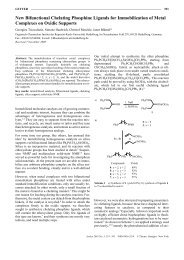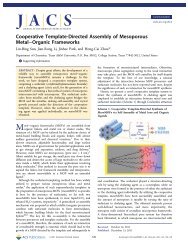Singlet Fission - Department of Chemistry
Singlet Fission - Department of Chemistry
Singlet Fission - Department of Chemistry
You also want an ePaper? Increase the reach of your titles
YUMPU automatically turns print PDFs into web optimized ePapers that Google loves.
R Chemical Reviews, XXXX, Vol. xxx, No. xx Smith and Michl<br />
where the one coefficient CS k , three coefficients CT k,l , and<br />
five coefficients CQ k,l are the amplitudes <strong>of</strong> the singlet, triplet,<br />
and quintet spin states in the sublevel k, and S, T, and Q<br />
are the earlier defined space parts <strong>of</strong> the wave functions <strong>of</strong><br />
the singlet, triplet, and quintet sublevels, respectively. It was<br />
first proposed by Merrifield 16 that the triplet fusion rate<br />
constant increases with the number <strong>of</strong> sublevels k for which<br />
CS k is different from zero.<br />
The normalization is<br />
9<br />
∑<br />
k)1<br />
k<br />
ψk ) SCs|S> + Τ∑<br />
l)2<br />
k 2<br />
|CS| ) 1, ∑<br />
k)1<br />
9<br />
∑ l<br />
In the absence <strong>of</strong> magnetic field (indicated by zero in<br />
parentheses), it is convenient to use a basis set <strong>of</strong> spin<br />
functions constructed from the eigenfunctions <strong>of</strong> the total<br />
spin dipole-dipole operator Hss,<br />
for the two chromophores A and B, cf. eq 17. There are<br />
nine pair states, |xAxB>,|xAyB>,|xAzB>,|yAxB>, etc. The singlet<br />
function is<br />
in a frame <strong>of</strong> axes in which the total Hss defined in eq 21 is<br />
diagonal. In the case <strong>of</strong> heter<strong>of</strong>ission, and also in the general<br />
case <strong>of</strong> hom<strong>of</strong>ission, the magnetic axes <strong>of</strong> A and B do not<br />
coincide and this frame has to be constructed from those <strong>of</strong><br />
A and B by tensorial addition. The situation simplifies when<br />
the magnetic axes on A and B are the same, as is the case<br />
in polyacene crystals due to fast exciton hopping, and this<br />
is the only case that we will consider.<br />
In a strong magnetic field H, the eigenfunctions <strong>of</strong> the<br />
Zeeman Hamiltonian gH · S represent a preferable basis set,<br />
and in this basis,<br />
where |0A0B>, |+A-B>, and |-A+B> are the spin eigenstates<br />
<strong>of</strong> A and B with spin angular momentum quantized along<br />
the direction <strong>of</strong> the magnetic field.<br />
Small 1 (TT), 3 (TT), and 5 (TT) Energy Difference<br />
4<br />
C T<br />
k,l |T l > + Q∑ l)5<br />
k,l 2<br />
|CT | ) 3, ∑<br />
k)1<br />
2 2<br />
Hss ) Hss (A) + Hss (B) ) DA (SAz - SA /3) +<br />
This situation is typical for chromophores packed in<br />
molecular crystals and probably applies also in stacked<br />
dimers. It was examined in great detail nearly half a century<br />
ago in connection with the interpretation <strong>of</strong> magnetic field<br />
effects on triplet fusion and singlet fission in polyacene<br />
crystals and was summarized in a review chapter. 1 In the<br />
following, we provide a condensed version and refer the<br />
reader to the original for details.<br />
9<br />
9<br />
∑ l<br />
k,l l<br />
CQ |Q ><br />
(19)<br />
k,l 2<br />
|CQ | ) 5<br />
(20)<br />
2 2 2 2 2 2<br />
EA (SAx - SAy ) + DB (SBz - SB /3) + EB (SBx - SBy )<br />
(21)<br />
|S(0)> ) 3 -1/2 (|x A x B > + |y A y B > + |z A z B >) (22)<br />
|S(H)> ) 3 -1/2 (|0 A 0 B > - |+ A - B > - |- A + B >)<br />
(23)<br />
Field Strength Dependence<br />
It is apparent from eq 22 that, in the absence <strong>of</strong> magnetic<br />
field, singlet character is distributed over only three <strong>of</strong> the<br />
nine states, |xAxB>, |yAyB>, and |zAzB> when A and B are<br />
symmetry equivalent (when they are not, it may be distributed<br />
over all nine states). The very weak intermolecular spin<br />
dipole-dipole interaction removes the degeneracy <strong>of</strong> terms<br />
such as |xAyB> and |yAxB>, and in zero field the resulting<br />
nine pair states take the form<br />
|S(0)> and |Q(0)>, |x A x B >,|y A y B >, and |z A z B > (24)<br />
|Q(0)>, 2 -1/2 (|xAzB > + |zAxB >),<br />
2 -1/2 (|xAyB > + |yAxB >), 2 -1/2 (|yAzB > + |zAyB >)<br />
|T(0)>, 2 -1/2 (|xAzB > - |zAxB >),<br />
2 -1/2 (|xAyB > - |yAxB >), 2 -1/2 (|yAzB > - |zAyB >)<br />
It is apparent that the spin functions |S> and |Q> are<br />
symmetric and the functions |T> are antisymmetric with<br />
respect to the exchange <strong>of</strong> A and B. For hom<strong>of</strong>ission and<br />
hom<strong>of</strong>usion this exchange can be a symmetry operation, and<br />
in the case considered presently, it is. Then, the three triplet<br />
states cannot mix with the other six states, and the situation<br />
simplifies. Note that this is not the case if A and B are<br />
different (heter<strong>of</strong>ission) or inequivalent due to orientation,<br />
solvent interactions, etc. Because the intermolecular spin<br />
dipole-dipole interaction that establishes the distinction<br />
between the symmetric and antisymmetric states is only very<br />
weak, it will not take much perturbation to break this<br />
selection rule. As long as the rule applies, 3 (TT) states cannot<br />
fuse to the S1 state, but can only form an upper triplet Tn or<br />
a vibrationally hot T1 state on A or B. 87<br />
If no two states with partial singlet character are degenerate,<br />
and if coherences can be neglected (diagonal density<br />
matrix), the overall rate constant γ′ for singlet fission, defined<br />
in eq 1, is given by<br />
9<br />
γ′ ) ∑ k)1<br />
k 2 k 2<br />
k-2 |CS| /(1 + ε|CS|<br />
) (25)<br />
where k-2|CS k | 2 is the rate <strong>of</strong> formation <strong>of</strong> the kth substate<br />
and ε is the branching ratio, ε ) k2/k-1, which defines the<br />
fraction <strong>of</strong> the singlet correlated triplet pairs 1 (TT) that return<br />
to S1 instead <strong>of</strong> proceeding to T1 + T1. Similarly, for the<br />
overall rate constant γS for triplet fusion to yield the singlet<br />
S1, we have<br />
9<br />
γ S ) (k 1 /9)∑ k)1<br />
k 2 k 2<br />
ε|CS| /(1 + ε|CS|<br />
) (26)<br />
where k1/9 is the rate <strong>of</strong> formation <strong>of</strong> each <strong>of</strong> the nine<br />
sublevels from thermalized triplet excitons. Similar expressions<br />
can be written for rate constants for fusion yielding a<br />
triplet or a quintet state on A or B (the quintet is usually not<br />
energetically accessible).<br />
In the presence <strong>of</strong> the magnetic field, the Zeeman term<br />
gH · S needs to be added to Hss in eq 21. If the field is<br />
weak and gH is approximately equal to D, the <strong>of</strong>f-diagonal<br />
elements <strong>of</strong> Hss will then mix all nine sublevels. This will<br />
provide a larger number <strong>of</strong> these states with some singlet<br />
character, and the fission and fusion rate constants γ′ and



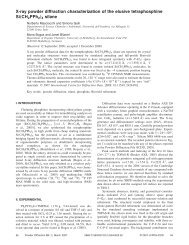

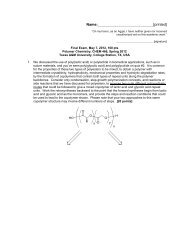

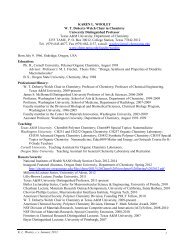
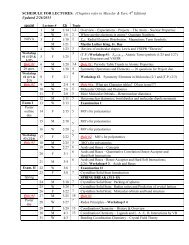
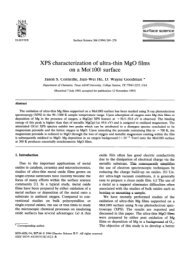
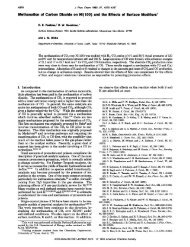
![Radical salts of TTF derivatives with the metal–metal bonded [Re2Cl8]](https://img.yumpu.com/10115211/1/190x253/radical-salts-of-ttf-derivatives-with-the-metal-metal-bonded-re2cl8.jpg?quality=85)



